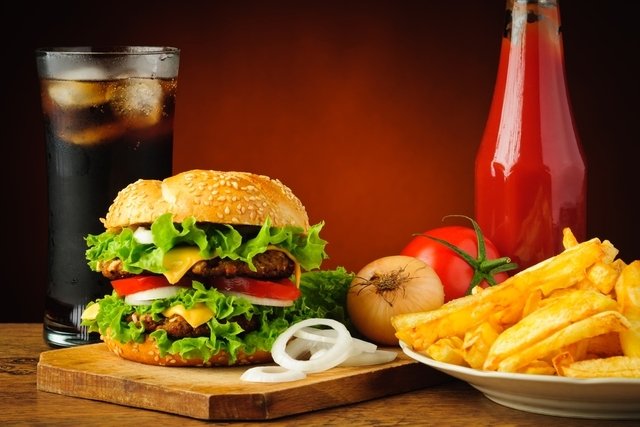After eating fast food, which is food rich in simple carbohydrates, salt, fat and artificial preservatives, the body first goes through a state of ecstasy due to the effect of sugar on the brain, and then suffers more serious consequences such as hypertension, heart disease and obesity. .
Fast food is usually very high in calories and can consist of foods such as sandwiches, hamburgers, pizzas, fries, milk shakes, nuggets and ice cream. In addition to the high calorie content that promotes weight gain, see below what happens in the body up to 1 hour after consuming fast food.

What happens 1 hour after eating fast food
The following data are examples of what happens after eating a Big Mac-type fast food hamburger.
10 minutes later: Euphoria
Excess calories from food cause a feeling of security in the brain, which was designed to think that the more calories there are to store, the more security it can provide the body in possible times of crisis and food shortages. Thus, eating fast food initially has an effect of greater security and a feeling of survival, but this will quickly wear off.
20 minutes later: Blood glucose peak
Fast food breads are rich in fructose syrup, a type of sugar that quickly enters the bloodstream and raises blood sugar levels. This spike in blood sugar leads to the production of the neurotransmitter dopamine, responsible for giving a feeling of pleasure and well-being. This effect on the body is similar to that of drugs, and is one of those responsible for fueling the frequent consumption of fast food.
30 minutes later: Pressure peak
All fast food is usually very rich in sodium, the salt component that is responsible for increasing blood pressure. About 30 minutes after eating a sandwich, sodium will be in excess in the bloodstream and the kidneys will have to eliminate more water to reduce this excess.
However, this mandatory adjustment causes dehydration, which is often confused with hunger and a new desire to eat more fast food. If this cycle repeats itself constantly, the problem of hypertension will certainly appear.

40 minutes later: Want to eat more
After about 40 minutes, a new desire to eat appears, due to the lack of control in blood sugar. Shortly after eating the sandwich, blood sugar increases and the body is forced to release hormones that lower blood sugar, in order to control the sugar spike that occurred.
Whenever blood sugar drops, signals are triggered that indicate that the body is hungry, as its sugar levels need to be replenished with more food.
60 minutes: Slow Digestion
In general, it takes the body 1 to 3 days to completely digest a meal. However, because it is rich in fat, preservatives and trans fats, fast food typically takes more than 3 days to be fully digested, and the trans fat contained in it can take up to 50 days to be processed. Furthermore, this type of fat is most linked to heart problems, obesity, cancer and diabetes.
Other changes in the body

In addition to the effects immediately after eating fast food, other changes may occur in the long term, such as:
- Weight gaindue to excess calories;
- Tirednessdue to excess carbohydrates;
- Non-cholesterol increaseas it contains trans fats;
- Pimples on the faceas the increase in blood sugar favors the appearance of acne;
- Swellingdue to the fluid retention caused by excess salt;
- Increased risk of cancerdue to the high content of trans fat and chemical substances such as phthalates, which cause changes in cells;
Therefore, it is clear that frequent consumption of fast food brings a lot of harm to health, and it is important to improve eating habits and have a healthy lifestyle routine, with a balanced diet and physical activity.
Now, watch this video to lose weight and get rid of bad eating habits in a good mood and without suffering:





